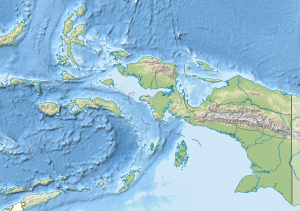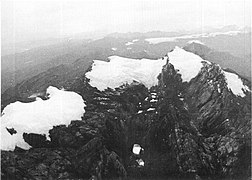Puncak Jaya
| Puncak Jaya | ||
|---|---|---|
|
The summit of Puncak Jaya |
||
| height |
4884 m (according to outdated information: 5030 m ) |
|
| location | Indonesia , Papua Province | |
| Mountains | Maoke Mountains ( Sudirman Range ) | |
| Dominance | 5261 km → Yulong Xueshan | |
| Notch height | 4884 m | |
| Coordinates | 4 ° 4 '44 " S , 137 ° 9' 30" E | |
|
|
||
| First ascent | February 13, 1962 by Heinrich Harrer , Philip Temple , Russel Kippax and Albert Huizenga | |
| Normal way | North face, path of the first climbers, III – IV, most difficult point V | |
| particularities | Highest mountain in Indonesia and Oceania | |
|
Satellite image of the Puncak Jaya (mid-2005), the copper mine in the front left and the remains of a glacier in the top right. The summit is at the top of the outermost point of the central rib. |
||
The Puncak Jaya [puntʃaʔ dʒaja] ( Bahasa Indonesia : "Victory Peak"), even Carstensz Pyramid and earlier Djalaspitze called, is with 4884 m the highest mountain in Oceania and the world's highest mountain on an island . It is located in the Indonesian province of Papua , one of the two provinces in western New Guinea on the island of New Guinea . The Puncak Jaya belongs to the Sudirman Range , which is part of the Maoke Mountains . This is of alpine origin and was created by the submergence of the Pacific plate under the Indo-Australian plate .
The largest gold mine in the world, the Grasberg mine, is located in the immediate vicinity of the mountain .
Seven Summits
There is a discourse on the question of whether the Puncak Jaya, representing Australia and Oceania, belongs to the Seven Summits , the highest mountains on the seven continents, or not. Politically, the mountain belongs to Indonesia and thus to Asia. On the other hand, the Carstensz pyramid lies on the Australian plate and therefore does not belong geologically to Eurasia.
history
The mountain was named "Carstensz Pyramid" after the Dutch navigator and explorer Jan Carstensz , who described it for the first time in 1623. The first ascent took place on February 13, 1962 by Heinrich Harrer , Philip Temple , Russel Kippax and Albert Huizenga with the help of over 100 Dani porters over the north face (the expedition report can be found in Harrer 1976, pp. 13-79).
Of the "Seven Summits", the Puncak Jaya is one of the technically most difficult mountains to climb, although it is comparatively low. With a degree of difficulty of V, an ascent is, in terms of climbing technology, more difficult than Mount Everest or Denali (Mount McKinley). But if you take into account the altitude and the prevailing temperatures, the latter two are a far greater mountaineering challenge.
At Puncak Jaya, clouds usually come up early in the morning. The fine weather days with a clear view of the Arafurasee 120 km away , as experienced by Jan Carstensz, are very rare . The Colijn expedition, during which Dozy discovered the Grasberg mine in 1936 , gave up due to thick fog, snowstorms and thunderstorms. At the neighboring Grasberg mine there is an annual precipitation of 4,000 to 5,000 mm.
tourism
The journey to Puncak Jaya and its ascent are dependent on several permits from the army, police and ministries. The regulations for obtaining these permits can change very quickly. For example, in November 1995 the mountain was banned from public access due to political unrest by the Indonesian government. No expeditions were allowed there until 2005. After that, individual ascents were approved again upon request. However, travel routes have already been blocked for an indefinite period of time, so that in the meantime it was only possible to arrive by helicopter. For several years there have been individual expeditions on the classic Phil Temple Trail from Ilaka to Maerendal, the base camp under the Puncak Jaya, which was also used by the Heinrich Harrer expedition.
There are also several mining companies in the area, particularly the American Fremont Mine, which do not welcome foreign visitors and prohibit entry into the mine. In addition, there are conflicts between the state Muslim-oriented authorities in Indonesia and the indigenous people, who can look back on a long tradition of Christian missionary work. In 2006 the wearing of the "kuteka", the penis tutu, was officially banned by the Muslim government authorities. It is precisely this state regulation that has led to traditionally oriented indigenous people turning to this custom again in order to underline their independence, at least in the remote mountain regions. Since the indigenous “Danis” have been able to earn money transporting their luggage for western expeditions, a new opportunity has opened up for daring mountaineers who like to forego the luxury of traveling by helicopter.
Minor peaks
The Ngga Pulu, a peak just 3 kilometers away in the same massif, is now regarded as a secondary peak of the Puncak Jaya because of its low dominance and notch height . According to another opinion, it should be a separate mountain. In 1936, before the glaciers melted, the Ngga Pulu with its ice cap was higher than the Puncak Jaya.
literature
- Heinrich Harrer: I come from the Stone Age. Eternal ice in the jungle of the South Seas. Pinguin-Verlag et al., Innsbruck et al. 1976, ISBN 3-524-00331-1 .
- Geoffrey S. Hope, James A. Peterson, Uwe Radok, Ian Allison (Eds.): The equatorial glaciers of New Guinea. Results of the 1971–1973 Australian Universities' Expeditions to Irian Jaya: survey, glaciology, meteorology, biology and palaeoenvironments. Balkema, Rotterdam 1976, ISBN 90-6191-012-9 , digital version (PDF; 17 MB) .
- Reinhold Messner: Departure for adventure. Mountain experiences from five continents. Verlagsanstalt Athesia, Bozen 1972, pp. 102–114.
- Francis Slakey: I Went to Indonesia, And Ran Into a Mountain of Trouble. In: The Washington Post . December 7, 2003, p. B05, English preliminary version of the article describing a confrontation between climbers and the military at the Freeport mine.
- Philip Temple: Snow over the rainforest. With Heinrich Harrer on the peaks of New Guinea (= Goldmann 71194 National Geographic ). Goldmann, Munich 2003, ISBN 3-442-71194-0 .
Web links
- Kalman Muller: Image gallery Puncak Jaya from north, south and west in bright sun
- Gerhard Schmatz: Ascent of the Carstensz pyramid in 1991 with a 7-day approach from Ilaga (like Harrer, but with good weather).
- Petr Jahoda: carstenszpapua.com English reports, photos, permits
- 7 summits
- Puncak Jaya on GeoFinder.ch
Individual evidence
- ↑ a b Carstensz Pyramid - Climbing History. (No longer available online.) In: www.abc-of-mountaineering.com. Archived from the original on May 16, 2011 ; accessed on October 14, 2010 (English). Info: The archive link was inserted automatically and has not yet been checked. Please check the original and archive link according to the instructions and then remove this notice.
- ^ Carstensz Pyramid (Puncak Jaya) - The history of climbing. In: CarstenszPapua.com. Retrieved October 14, 2010 .
- ^ Carstensz Pyramid. Summit of Oceania, 4884m. In: 7summits.com. Retrieved October 14, 2010 .
- ↑ Description of the Colijn Expedition 1936 in: Jean-Jacques Dozy : From the highest peak to the deepest pit. Discovery and development of gold and copper ore deposits of Irian Jaya, Indonesia. In: Bulletin for Applied Geology. Vol. 7, No. 1, 2002, pp. 67-80, doi : 10.5169 / seals-223646 .




